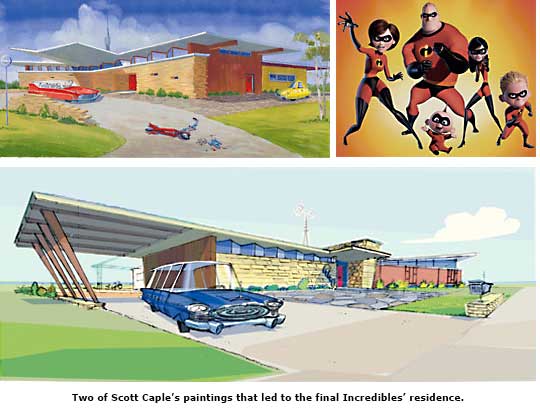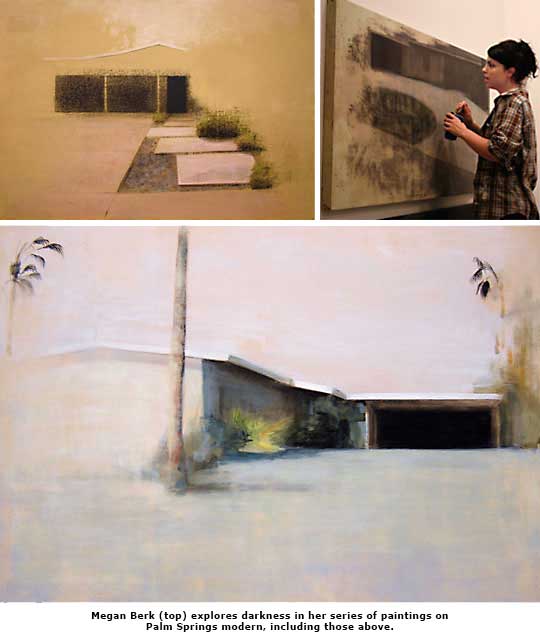Art Imitates Life: Artists Inspired by Modern Architecture - Page 2
But the optimism that inspires Caple and Reed comes with a darker side. The nuclear family is as imperfect a unit as can be found anywhere, with undercurrents of discord and unhappiness juxtaposed with togetherness and domestic bliss. Megan Berk explores that darkness in her series of Palm Springs modern homes, on which she embarked after falling in love with the homes' look on a visit to the desert city.
"I'm seduced by a lot of it in terms of middle-class comfort and style and leisure. But at the same time I'm put in a position of wanting to criticize it," Berk says. "For me it was really landing on something where I had my foot in two places. It said something about me as a painter, wanting both beauty and grit."
Taking a break in her Brooklyn studio, Berk gestures to a black-and-green portrait of the front of a mid-century modern home. The yard and driveway are clearly defined, as is the shape of the house, but the entrance is shrouded in darkness.
"You have to work your way in there imaginatively. The straightforward, aesthetic pleasures of the front of the house are kind of right there, but I used shadows a lot to kind of suggest the unknown lairs of the life that's lived within," Berk says.

"It's a way of feeling out some problematic desires [that] I think a lot of people have, especially women," Berk says. "The kind of things I paint, I think, tie into identity issues for me, because I've always been very enticed by a lot of ideas about domestic life—the domestic life of my grandmother, basically—aesthetically and in a lot of very little ways. I pull my identity from her era, and that can be problematic on a personal level. You're thinking about a life, a domestic life, that maybe does or maybe doesn't mesh with your career goals or independence."
Berk's at-odds relationship with her subject matter comes in part from the economic realities of today. While the middle part of the 20th century was a time when many young Americans found success and affordable suburban housing, these days home-ownership can lead to serious financial trouble. The real estate crash of 2008 happened as Berk created many of her paintings, and it informed her work. "The idea of a dream home has become a very dangerous idea," she says.

The elusiveness of the 'American dream' plays into Danny Heller's work as well, though with less blatant suspicion than Berk's, leaving more up to the imagination of the viewer. He paints hyper-realistic scenes that feel almost like snapshots. Using few depictions of people or activity, his works often make the viewer feel as if he or she is driving down a suburban street on a quiet weekday afternoon, wondering what stories might lie behind the doors of each house.
"That American dream is still being perpetuated but also altered. It seems like families are still the same but also different from what was going on in that [mid-century] period," Heller says.

"The family dynamics have changed. Instead of the nuclear family, maybe it's a couple, or maybe it's more people working from home instead of the stay-at-home mom and the father that goes out to work."
But the look and feel of the neighborhood stays the same, Heller says, which throws the changing nature of our culture into relief.
"You have those real-trimmed hedges, [such as in the movie] 'Edward Scissorhands' or something, topiaries. You have the rock siding on some of the homes, older mailboxes, things like that. If you get inside them, a lot of times there's still that kind of time warp. You'll have a computer or cell phone around to show that it's the year 2009, but the drapes and the furniture and the lighting go back to those earlier times," Heller says.
Like Nat Reed, Heller says part of his attraction to the homes as subjects for his paintings comes from their apparent plainness; again, the sense of them being artwork that goes unnoticed even though we see it every day.
"It's not necessarily hidden, it's out in the open. It's in plain sight but people might not stop and look, or maybe they get turned away on the surface because it looks like a bland suburb," he says.
The context in which these homes are usually seen—that is, as residential suburbs forgotten in bedroom communities—colors how we see them as art, Heller says. "Sometimes a lot of the same stuff is preserved in the city. There it has some kind of recognition. But since it's in the suburbs, it's overlooked," he says.




